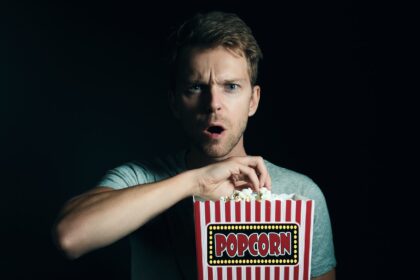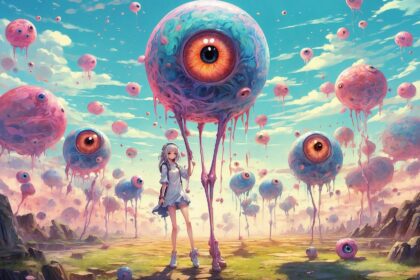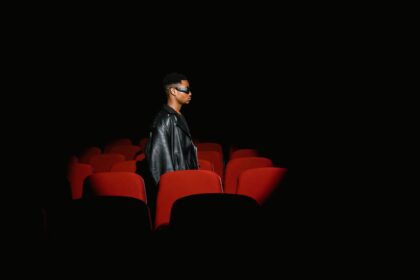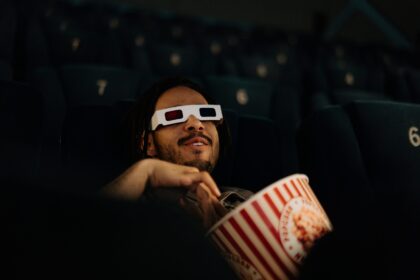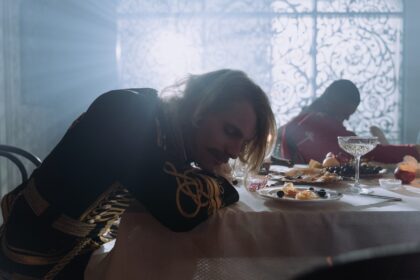On the Periphery: Films Indirectly Exploring Lucid Dreaming
While we’ve delved into films that focus directly on lucid dreaming, such as exploring the 10 Best Films Showcasing Lucid Dreaming, Psychological Thrillers and Lucid Dreaming, TV Series Featuring Lucid Dreams, and Lucid Dreaming Animated Films, there’s a plethora of cinematic treasures that flirt with the edges of this intriguing phenomenon. They don’t make lucid dreaming their focal point, yet they still weave a compelling tapestry where dreams and reality blur and challenge our perceptions.
This trip into the outskirts of lucid dreaming resembles a delightful detour from the mainstream path. It’s akin to choosing the scenic route on a road trip, relishing unexpected vistas rather than rushing to the destination. Here we find films that echo elements of lucid dreaming, much like a hushed whisper in a Grand Canyon – subtly present, yet not fully there.
On this journey, we explore narratives ranging from psychological thrillers blending nightmares and reality to fascinating tales interweaving identity and perception. The direct mention of lucid dreaming might be absent, but the interplay of dreams and reality, the semblance of awareness and control within the dream state, surely resonates with those intrigued by the concept. Just remember to bring along your sense of curiosity and an open mind!
A Nightmare on Elm Street (1984-2010)
For a sleep-terrorizing jaunt into the world of dream infiltration, look no further than the spine-chilling saga “A Nightmare on Elm Street.” This horror franchise, stretching from 1984 to 2010, unveils the nightmare-inducing antics of Freddy Krueger, a spectral slasher terrorizing the dreamscape of unsuspecting teens. Wes Craven, the mastermind behind the 1984 classic, brilliantly blended horror and lucid dreaming into a uniquely terrifying cocktail. Freddy’s reign of terror continued into the 21st century with a 2010 remake set in an imaginary Ohio town, continuing the dream-stalking tradition.
While not a study in lucid dreaming, the franchise ingeniously employs the concept as a defensive tool against Krueger’s nocturnal invasions. Critically lauded for its innovative blending of dreams, reality, and horror, the original film etched Freddy Krueger into the annals of horror iconography. The 2010 remake, met with mixed reviews, added a dash of modern visuals and special effects to the tried and true recipe. Despite their notoriety, these films offer a tangential glimpse into lucid dreaming wrapped up in a shudder-inducing package.
The Congress (2013)
In his 2013 science-fiction film “The Congress,” Ari Folman actively explores the line between reality and fiction, delving into the profound effects of technology on human consciousness. The film blends lucid dreaming and virtual reality elements in an artful marriage of live-action and animation. Based on Stanisław Lem’s novel “The Futurological Congress,” it follows the tale of actress Robin Wright, who consents to her identity being digitized for use in a fantasy-filled virtual world.
The movie doesn’t center around lucid dreaming but presents it as a tool for Wright’s character to create personal dream realities, acting as an escape from the stark reality of her existence. However, it’s a double-edged sword, with the film striking a balance between presenting lucid dreaming as a powerful tool for self-exploration and cautioning its potential danger when used to evade reality or set unrealistic life expectations. The plot triggers profound musings on identity, the potential of technology, and the very nature of existence. Despite its ambitious storytelling drawing mixed reviews, “The Congress” provides a visually stunning and contemplative glimpse into the intriguing realm of lucid dreaming.
Perfect Blue (1997)
Satoshi Kon’s animated psychological thriller might not make lucid dreaming its centerpiece, yet it dares to dance with themes that echo eerily with the territory of dreaming consciously. The film captures the unraveling reality of Mima Kirigoe, an ex-pop idol turned actress, whose world crumbles into a disorienting mosaic of dreams, delusions, and the ‘real’ world. Imagine constantly waking from a dream, only to wonder if you’re still dreaming – that’s Mima’s plight, a nod to the slippery slopes of lucid dreaming where reality often gets muddled.
Juxtaposing fame’s darker shades with the disintegration of selfhood, “Perfect Blue” submerges viewers into an abyss where the line between reality and imagination is blurred – a space where lucid dreamers often find themselves. It’s an exquisite mind-bender, dwelling on themes that lucid dream enthusiasts might find eerily familiar. And even though Satoshi Kon didn’t hand out pamphlets on lucid dreaming, his intricate storytelling teases a world where perception could be as fragile as a dream and as deceptive as a mirage. There’s no spoon-fed clarity here, folks – in “Perfect Blue,” just like in a lucid dream, what’s real is all up to you!
Source Code (2011)
While it doesn’t exactly showcase lucid dreaming, this sci-fi thriller, directed by Duncan Jones, surely presents exciting twists on consciousness that can surprise even expert dream explorers. We journey with Captain Colter Stevens, played by Jake Gyllenhaal, who finds himself in a ‘Groundhog Day’ style time-loop, reliving the last eight minutes of another man’s life on a train. The twist? He’s hunting for a bomber to prevent a catastrophic future event.
So while Stevens isn’t consciously controlling his dreams, his predicament does resonate with the dream-like sensation of being in a parallel reality, familiar territory for lucid dreamers. His journey delves into the notions of fate and free will and questions the ethics of manipulating past events – familiar debates in the lucid dreaming sphere. So while “Source Code” doesn’t dabble in lucid dreaming, per se, it’s an adrenaline-filled roller-coaster ride that explores the elasticity of consciousness and challenges our perception of reality – elements that are sure to intrigue lucid dream aficionados and sci-fi fans alike.
eXistenZ (1999)
David Cronenberg’s eerie science fiction horror film “eXistenZ” (1999) may not focus on lucid dreaming, but it dances around the edges of the concept in fascinating ways. The movie tracks game designer Allegra Geller and marketing trainee Ted Pikul as they navigate a virtual reality game that feels eerily similar to a lucid dream, so much so, you can almost hear the whispering question, “Am I awake, or is this a dream?”
The game in “eXistenZ” crafts its narrative within the player’s mind, much like a lucid dream. Its reality is elastic, bending and blurring the boundaries between the game and the real world. As our protagonists journey deeper into the game, they start questioning the authenticity of their experiences – a dilemma every lucid dreamer faces. Cronenberg uses this tension to comment on the addictive nature of immersive gaming and to explore more prominent themes of identity and reality. While it might not be a stroll through the park of lucid dreaming, “eXistenZ” offers a dizzying roller-coaster ride through similar mind-bending territory, sure to intrigue any lucid dream explorer or sci-fi fan.
The Nightmare (2015)
Director Rodney Ascher takes us on a chilling tour of the world of sleep paralysis, a phenomenon often as terrifying as any horror movie. This documentary-style terror fest combines vivid interviews with eight people who have experienced sleep paralysis with dramatic recreations of their encounters with night terrors. It’s enough to make even the bravest of us check under the bed before going to sleep!
While sleep paralysis is the central theme, “The Nightmare” also edges into lucid dreaming territory. As a potential salve for those tormented by nightmares, lucid dreaming offers the possibility of gaining control of these dreams, turning the horror show into something more benign, maybe even pleasant. Just imagine turning that monstrous night terror into a playful kitten with the power of your mind! Despite some critics longing for a more scientific dissection of the phenomena, “The Nightmare” takes you on an intense, personal journey into the unsettling world of sleep disorders, certain to intrigue lucid dreamers, scare enthusiasts, and the general audiences alike.
The Lovely Bones (2009)
Peter Jackson’s supernatural thriller drama “The Lovely Bones” may not dive straight into lucid dreaming, but it plays beautifully with themes of consciousness and alternate realities. The film takes us through the tragic journey of 14-year-old Susie Salmon, portrayed by Saoirse Ronan, who, after being brutally murdered, watches over her family from her personal Heaven, weaving a story of love, loss, and the pursuit of justice.
This cinematic journey might not let you walk in a dream while being aware, but it captivates the audience by blurring the boundaries between life and the afterlife. While the critics had a mixed bag of reactions, audiences appreciated the performances, especially those of Ronan and Stanley Tucci, who played the chilling antagonist. The movie was also a commercial hit, raking over $93 million worldwide. So, while you won’t find any textbook lucid dreaming in “The Lovely Bones,” its exploration of otherworldly realms and compelling narrative make it a worthy watch for dream enthusiasts and film lovers alike.
Alice In Wonderland (2010)
In the heart of Tim Burton’s “Alice in Wonderland,” Alice, portrayed by Mia Wasikowska, finds herself in a whirlwind of whimsy that could make even seasoned lucid dreamers feel right at home. She joins characters like Johnny Depp’s Mad Hatter and moves through a world full of weird creatures and odd situations, much like the surprising unpredictability of lucid dreams.
Though Alice isn’t consciously controlling her adventures, her journey pushes the boundaries of reality, not unlike a lucid dream. Coupled with Burton’s signature vibrant visuals and eclectic cast, the film strikes a unique balance between the fantastical and the familiar. As she defies the oppressive Red Queen, brilliantly portrayed by Helena Bonham Carter, Alice uncovers her inner strength and individuality. So, while not a lucid dream film per se, “Alice in Wonderland” is a vibrant, dream-like escapade that’ll tickle the fancies of dream enthusiasts and fantasy lovers alike.
Donnie Darko (2001)
“Donnie Darko” is a unique cocktail of dreams, time travel, and alternate realities. The protagonist, Donnie, played by Jake Gyllenhaal, is your average awkward teenager, except for his buddy, Frank—a humanoid rabbit. Frank guides Donnie through strange visions and an alarming prophecy of the world’s end. Although Donnie might not be controlling his dreams in the typical sense of lucid dreaming, his encounters with Frank and their time-traveling antics might make you question the line between dreams and reality.
Richard Kelly wrote and directed this American science fiction psychological thriller, and it goes beyond just exploring dreams. It delves into themes of fate, determinism, mental illness, and even the very nature of existence. The movie’s cult following is a testament to its mind-bending narrative and unorthodox storytelling. While it doesn’t put lucid dreaming center stage, “Donnie Darko” has a dream-like plot that fans of existential rabbit holes will undoubtedly appreciate. So, hop in and get ready for a wild ride!
The Imaginarium of Doctor Parnassus (2009)
Step right up to the fantastical ride “The Imaginarium of Doctor Parnassus,” a creation of the imaginative mind of director Terry Gilliam. While the film doesn’t directly tackle lucid dreaming, it sweeps you off to Doctor Parnassus’s Imaginarium—a whimsical, dream-like world that morphs according to the wishes of those brave enough to step through the mirror. This traveling show of the surreal may not offer an exact guide to lucid dreaming, but it surely lets you dive into dreamland, where the laws of physics and reality take a backseat.
Starring an ensemble cast, including the late Heath Ledger, the film is a surreal roller-coaster where Ledger’s character Tony quite literally flies high in the dreamy Imaginarium. The untimely demise of Ledger during production even added an unexpected twist, with Johnny Depp, Colin Farrell, and Jude Law stepping in as ‘transformed’ versions of Tony. “While the film isn’t strictly a guide to lucid dreaming, it’s still a whimsical exploration of dreams and the mind’s potential. Regardless of its IMDb rating of 6.8/10 and Rotten Tomatoes score of 64%, ‘The Imaginarium of Doctor Parnassus’ offers a captivating ticket into a theater filled with dream-like scenarios and imaginative landscapes.
Take Shelter (2011)
“Take Shelter” is an eerie psychological thriller directed by Jeff Nichols, featuring Michael Shannon as Curtis LaForche, a man wrestling with the nightmare of impending apocalypse. It’s not primarily about lucid dreaming, but the line it treads between dreams and reality could intrigue those keen on dream phenomena.
In this gripping tale set in a quiet Ohio town, Curtis’s apocalyptic visions bleed into his waking life, stirring up distress and doubts about his mental health, much like the lingering effects intense lucid dreams can have. As Curtis obsessively expands his backyard storm shelter, we see him alienating his community and loved ones. Is he protecting his family from the storm of his nightmares or his own unraveling sanity? That’s for you to figure out! This suspenseful film offers a riveting exploration of the intersection of dreams, fears, and perception and will likely linger in your mind long after the end credits roll.
Dead of Night (1945)
Dead of Night, a 1945 black-and-white British horror anthology, paved the way for future films in the genre with its groundbreaking narrative structure. Ealing Studios produced the film, which is a standout due to its thrilling stories and groundbreaking way of weaving together reality and dreams. Walter Craig, the protagonist, finds himself stuck in a recurring nightmare that escalates with each iteration.
Although not about lucid dreaming, this film blurs the lines between dream and reality, echoing some aspects of lucid dreaming without the control and awareness typically associated with it. So, if you’re into unsettling dream-like narratives and are okay with missing the full-on lucid dreaming action, ‘Dead of Night’ is worth checking out. Just please don’t blame me for any recurring nightmares afterward!
Enemy (2013)
In Denis Villeneuve’s puzzling thriller, “Enemy,” Jake Gyllenhaal grapples with the mysteries of identity and reality through his character Adam’s unsettling discovery of his doppelgänger, Anthony. The film doesn’t make lucid dreaming the star of the show, but it does weave it into its exploration of identity and duality. Adam, intrigued by his vivid, dream-like hallucinations of being Anthony, questions if he’s entering the realm of lucid dreaming – where he’s aware and can control the course of his dream.
In this weird journey, we find Adam diving deep into his identity and confronting his own duality. His lucid dreams aren’t just a playground for self-discovery; they also depict the transformative power of imagination. One standout scene has Adam creating an idyllic reality, hinting that imagination might just be the escape route from a grim reality. So, brace yourself as you delve into “Enemy” – a film that artistically blurs the lines between dream and reality, leaving you with plenty to ponder about identity, the power of dreams, and the elusiveness of reality.
Flatliners (1990)
In Joel Schumacher’s electrifying 1990 film “Flatliners,” five daring medical students, played by a star-studded cast featuring Kiefer Sutherland, Julia Roberts, and Kevin Bacon, flirt with the line between life and death in a risky experiment. While the film doesn’t explicitly claim to explore lucid dreaming, their provocative adventures into the afterlife resemble the vivid and controllable landscape of a lucid dreamer’s mind.
Through a cocktail of drugs and self-hypnosis, these brave (or foolhardy?) students plunge into near-death experiences that mirror lucid dreams’ introspective and dynamic realm. And while the film jazzes it up a bit—our adventurous gang seems to achieve lucidity in their dreams quicker than your average Joe—it essentially presents a decent depiction of this intriguing phenomenon. So buckle up for a wild ride with “Flatliners,” a film that tantalizingly treads the thin line between reality and the fantastical world of the unconscious mind, offering viewers a heady taste of life, death, and everything in between.
Shutter Island (2010)
Martin Scorsese’s gripping 2010 psychological thriller, “Shutter Island,” paints a haunting picture of the dreamscape. Leonardo DiCaprio plays Teddy Daniels, a U.S. marshal on a chilling assignment to find a missing patient from a mental asylum located on a storm-swept island. As Teddy dives deeper into the case, the border between reality and his mind starts to blur, with dream sequences hinting at lucid dreaming despite the term never explicitly entering the dialogue.
Teddy appears to exert control and maintain awareness in these enthralling dream sequences, much like a lucid dreamer would. He uses these dreams as his subconscious playground to solve the mystery, albeit a tad more effortlessly than your typical first-time lucid dreamer might. While the movie takes certain creative liberties, it provides an uncanny glimpse into the captivating world of lucid dreams. So, if you’re craving an eerie yet engrossing cinematic experience that weaves between the threads of reality and dreams, buckle up for a ride to “Shutter Island”— just remember to keep your sanity checked in!
Sucker Punch (2011)
Zack Snyder’s visual extravaganza, “Sucker Punch” (2011), whirls the audience into a cerebral world where dreams are weapons. Here we meet our tormented protagonist, Babydoll, brought to life by Emily Browning. Incarcerated in a grim mental institution by her vindictive stepfather, Babydoll crafts an alternate universe through her imagination, resembling a wild, lucid dreaming adventure where she morphs into a formidable warrior, and our mundane laws of physics need not apply.
Traversing through multiple realities: the actual asylum, a burlesque fantasy world, and adrenaline-pumping action dreams, Babydoll retains her awareness— a nod to lucid dreamers who navigate their dreams with full consciousness. Yet, not all is rainbows and butterflies in her dreamscapes, echoing the real-life spectrum of lucid dreaming that swings from exhilarating to unsettling. “Sucker Punch” is more than just a feast for the eyes; it’s a testament to the power of imagination as a coping mechanism against life’s cruel adversities. So, brace yourselves! Snyder isn’t just throwing a punch with this one; it’s a full-blown sucker punch that plunges you headfirst into the fantastical world of lucid dreaming!
Dreams Fade, Our Journey Continues
That about wraps up our wild trek through the cinematic fringes of lucid dreaming. Sure, these movies didn’t exactly put lucid dreaming front and center, but that’s what makes them so intriguing! Who needs a film that screams “lucid dreaming” from the rooftops when there’s so much fun to be had on the outskirts?
Whether you’re battling Freddy Krueger like a caffeinated ninja or frolicking with Tim Burton’s fantastical creatures, these films offer a tantalizing glimpse into the world where dreams and reality get all tangled up. Maybe they’re not a masterclass in lucid dreaming, but they sure get your mind thinking about mind-bending possibilities.

















